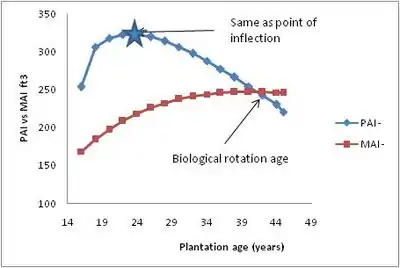Mean annual increment
The mean annual increment (MAI) or mean annual growth refers to the average growth per year a tree or stand of trees has exhibited/experienced to a specified age. For example, a 20-year-old tree that has a diameter at breast height (dbh) of 10.0 inches has an MAI of 0.5 inches/year. MAI is calculated as where Y(t) = yield at time t. Because the typical growth patterns of most trees is sigmoidal, the MAI starts out small, increases to a maximum value as the tree matures, then declines slowly over the remainder of the tree's life. Throughout this, the MAI always remains positive. MAI differs from periodic annual increment (PAI) because the PAI is simply the growth for one specific year or any other specified length of time.

The point where the MAI and PAI meet is typically referred to as the biological rotation age. This is the age at which the tree or stand would be harvested if the management objective is to maximize long-term yield. The proof of this definition is shown by differentiating MAI(t) with respect to t, and is shown by Husch, Miller, and Beers [1]
References
- Husch, B., Miller, C.I., and T.W. Beers. 1982. Forest Mensuration. Wiley. New York. 402 p.
Avery and Burkhart. Forest Measurements. Fifth Edition, McGraw Hill, New York. 2002.